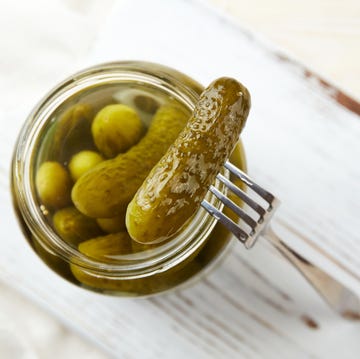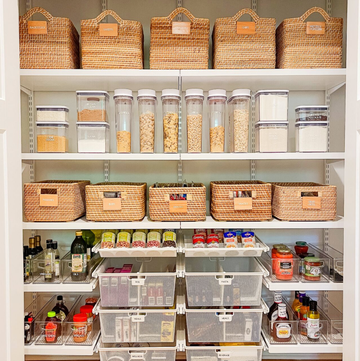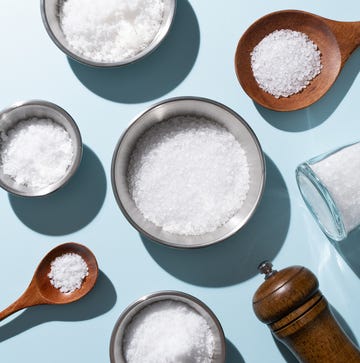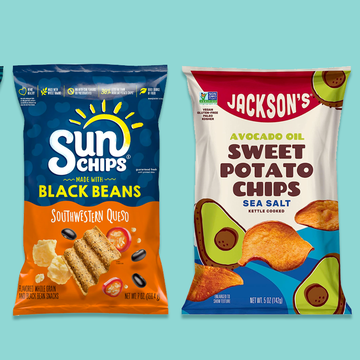Your pantry can be a haven for those meals you cobble together when you haven’t gone grocery shopping in a while. Pasta, rice and canned tuna are true weeknight heroes. But what happens when the shelves are overloaded with ingredients that have worn out their welcome? Do you really need to hold onto that yeast you panic-bought during the pandemic? Or the Tuscan herb olive oil Aunt Sally gave you for Christmas three years ago?
A well-organized pantry is one that’s stocked with essentials, but not glutted down with dead weight items. We often rely on our larder when we’re busy or in a rush, so decluttering it will help you see the ingredients you need immediately — and prompt you to use them before they expire or go stale. A hoarder mentality will only burden your cooking, like a culinary albatross around your neck. It can also be harmful to your health, if you accidentally consume compromised food products. Read on to find out the easy way to get rid of pantry duds and create a safe and chaos-free cupboard.
❌ Expired foods
This is the easiest category of ingredients to ditch because it’s pretty much undebatable. Take a look at the best-by dates on pantry items and throw away anything that’s past its time. This is the date the product may start losing freshness. Even if it’s still technically safe to eat, the food may begin to deteriorate in terms of taste and texture. Common culprits include: baby formula, breadcrumbs, chips and other snacks. The best-by date is different from the sell-by date, which stores use for inventory management and does not necessarily indicate if the food is safe to eat.
❌ Stale foods
There was a viral TikTok trend of raiding your parents’ spice cabinet to see how old the jars were and people were unearthing ground pepper, nutmeg and paprika dating back to the 1980s! While ground spices can last for about three years, they typically lose flavor and potency after six months. Consider this your sign to toss any spices older than three years or may have gone musty before then. The same holds true for stale cereal or snacks, like crackers and chips.
❌ Baking ingredients
We often think of baking ingredients as pantry mainstays that will always be there when we need them, but these same items are prone to getting infested with bugs like weevils, flour beetles or mites. Be sure to inspect packages of flour, cornmeal, baking mixes, oats and other grains, which can harbor these pantry pests. Sacks of sugar can attract ants and other bugs if they're not properly sealed.
Another reason to check baking ingredients? They can become deactivated over time. For example, baking powder typically remains effective for 6 months to 1 year after opening. Its effectiveness decreases, as it loses the ability to create the necessary chemical reaction for leavening. The same goes for baking soda: It’s most effective 6 months to 1 year after opening. If it’s older than three years, it’s time to say bye-bye, bicarbonate.
If you’re still holding on to yeast from the pandemic, it’s time to let it go. Unopened active dry yeast and instant yeast have a shelf life of two years. Once opened, that drops to four to six months.
❌ Cooking oils and fats
Take a whiff of the cooking oils and fats in your pantry and immediately toss any that have an off, rancid odor. Even the tiniest drop will ruin whatever it is you're making. Just don’t be tempted to pour them down the drain, where they can clog the pipes. Instead, safely dispose of them in their original container or in a resealable bag.
❌ Nuts and seeds
Nuts and seeds go rancid faster than you think. They have a high fat content, which accelerates their demise. Do a sniff test and immediately throw away any that have a sour, musty smell. To prolong their freshness, it’s better to store nuts and seeds in airtight bags or containers in the freezer.
❌ Dented Cans
The USDA site advises us to, “Discard deeply dented cans.” That refers a dent that’s deep enough that you can lay your finger into it. “If a can containing food has a small dent, but is otherwise in good shape, the food should be safe to eat,” according to the site. The issue with deep dents is that they often have sharp points that can damage the seam and allow bacteria to enter the can. To be safe, you may also want to discard any cans that have a dent on a seam, no matter the size.
❌ Dried beans
Those sacks of cannellinis and chickpeas that you rely on to last forever...actually won’t. After a couple of years, the beans will start losing their nutritional value, and most naturally found vitamins will be gone within five years. Old beans also take longer to cook so check the dates on those lentils and pintos and toss any that are past their prime.
❌ Maple syrup
While honey can literally last forever at room temp, pure maple syrup can go moldy if it’s unrefrigerated. If you keep this pancake topper in your pantry, pour out a glug into a clear glass. See signs of mold? It’s time to dump the entire container.
❌ Unwanted items
Maybe you’re holding onto food gifts and souvenirs for sentimental reasons but haven’t used them for a couple of years. It’s time to let them go (and we don’t mean repurposing them as White Elephant presents). That also goes for products you bought because you like the packaging or artwork on the label. Try to adhere to a strict use-it-or-lose-it policy when it comes to your pantry.















